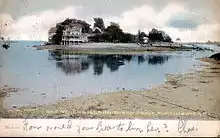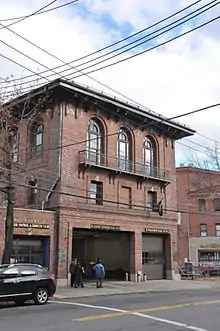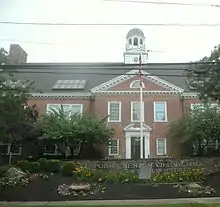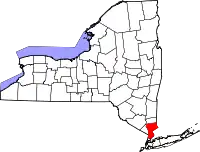Port Chester, New York
Port Chester is a village in the U.S. state of New York and the largest part of the town of Rye in Westchester County by population. At the 2010 census, the village of Port Chester had a population of 28,967 and was the fifth-most populous village in New York State.[3] In 2019, its population grew to a census-estimated 29,163 residents.[4] Located in southeast Westchester, Port Chester forms part of the New York City metropolitan statistical area. Port Chester borders the state of Connecticut and the town of Greenwich to the east. Port Chester is one of only 12 villages in New York still incorporated under a charter; other villages either incorporated or reincorporated under the provisions of Village Law.[5]
Port Chester, New York | |
|---|---|
Village | |
| Village of Port Chester | |
 Downtown Port Chester | |
 Seal | |
| Nickname(s): Gateway To New England | |
| Motto(s): "Rich History, Great Future" | |
 Location in Westchester County, New York | |
| Coordinates: 41°0′18″N 73°40′8″W | |
| Country | United States |
| State | New York |
| County | Westchester |
| Town | Rye |
| Government | |
| • Mayor | Fritz Falanka |
| • Board of Trustees |
|
| Area | |
| • Total | 2.40 sq mi (6.22 km2) |
| • Land | 2.33 sq mi (6.03 km2) |
| • Water | 0.07 sq mi (0.19 km2) |
| Elevation | 43 ft (13 m) |
| Population (2010) | |
| • Total | 28,967 |
| • Estimate (2019)[2] | 29,163 |
| • Density | 12,527.06/sq mi (4,836.38/km2) |
| Demonym(s) | Port Chesterian |
| Time zone | UTC-5 (Eastern (EST)) |
| • Summer (DST) | UTC-4 (EDT) |
| ZIP code | 10573 |
| Area code(s) | 914 |
| FIPS code | 36-59223 |
| GNIS feature ID | 0977392 |
| Website | https://www.portchesterny.com/ |


The village of Port Chester is nicknamed the "Gateway to New England" and serves as a transportation hub between New England states and New York. Its economy is primarily stimulated by small businesses, the local government, and several national chain stores, including Stop & Shop, Marshalls, Bed Bath & Beyond, T-Mobile and Metro by T-Mobile, Verizon, Boost Mobile, Staples, and Walgreens.
Etymology
The village was originally known as Saw Pit for the saw pits in use during the time. Logs were cut in holes in the ground for wood to be used for shipbuilding. The name Saw Pit was used for the first time in 1732. The village eventually outgrew this name and became Port Chester by incorporating as a village in 1868.[6][7][8]
History
In 1660, three settlers from Greenwidge (now Greenwich, Connecticut)—Thomas Studwell, John Coe, and Peter Disbrow—arranged to buy Manursing Island and the land near the Byram River from the Mohegan Indians. The land that they bought is now Port Chester. In 1665, the settlement (first known as Saw Pit) was claimed by both New York and Connecticut, but Connecticut gave the land to the New York Colony in 1683. The struggle over the ownership of Saw Pit continued for almost 105 years. In 1788, the Legislature of New York ruled that Saw Pit was a part of the town of Rye, New York.
Travel was considered dangerous in Saw Pit's early years as good roads were hard to find. The Boston Post Road, King Street, and Grace Church streets are some of the early migration paths in the Saw Pit/Rye settlement. Other roads were usually dirt, making water transportation important.[9] The local waterways (the Byram River and Long Island Sound) were a key part of the growth and development of Saw Pit/Port Chester. Early residents took part in boat building, farming, and shell fishing. When the village of Saw Pit was incorporated as Port Chester, it was considered a major seaport.
Steamships regularly sailed from Port Chester to New York City from 1870 until the First World War. The last two decades of the nineteenth century saw public services expand, and roads were widened and paved in the 1920s.[7] From the first and second world wars, over 5,000 men from Port Chester served. After the Second World War, numerous corporations established headquarters or production centers in Port Chester. Examples include Life Savers, whose former factory is now a residential building, which is evidence of Port Chester's progression from an industrial center to a suburban residential municipality.
Since the late twentieth and early twenty-first century, Port Chester has undergone several redevelopment proposals and projects.[10][11][12] The Port Chester Historical Society is a dedicated group of community members dedicated to learning and teaching the public about Port Chester local history.[13]
Demographics
| Historical population | |||
|---|---|---|---|
| Census | Pop. | %± | |
| 1870 | 3,797 | — | |
| 1880 | 3,254 | −14.3% | |
| 1890 | 5,274 | 62.1% | |
| 1900 | 7,440 | 41.1% | |
| 1910 | 12,809 | 72.2% | |
| 1920 | 16,573 | 29.4% | |
| 1930 | 22,662 | 36.7% | |
| 1940 | 23,073 | 1.8% | |
| 1950 | 23,970 | 3.9% | |
| 1960 | 24,960 | 4.1% | |
| 1970 | 25,803 | 3.4% | |
| 1980 | 23,565 | −8.7% | |
| 1990 | 24,728 | 4.9% | |
| 2000 | 27,867 | 12.7% | |
| 2010 | 28,967 | 3.9% | |
| 2019 (est.) | 29,163 | [2] | 0.7% |
| U.S. Decennial Census[14] | |||
As of the census[15] of 2010, there were 28,967 people, 9,240 households, and 6,348 families residing in the village. The population density was 11,722.5 people per square mile (4,526.1/km2). There were 10,046 housing units at an average density of 4,185.8 per square mile (1,646.9/km2). The racial makeup of the city was 31.6% White, 5.3% African American, 0.2% Native American, 2.0% Asian, 0.0% Pacific Islander, 0.7% some other race, and 0.9% from two or more races. Hispanic or Latino of any race were 59.4% of the population.[3]
There were 9,240 households, out of which 33.9% had children under the age of 18 living with them, 46.5% were headed by married couples living together, 14.3% had a female householder with no husband present, and 31.3% were non-families. 24.2% of all households were made up of individuals, and 10.0% had someone living alone who was 65 years of age or older. The average household size was 3.08 and the average family size was 3.54.[3]
In the city the population was spread out, with 22.6% under the age of 18, 9.6% from 18 to 24, 34.2% from 25 to 44, 22.7% from 45 to 64, and 10.6% who were 65 years of age or older. The median age was 34.4 years. For every 100 females, there were 110.3 males. For every 100 females age 18 and over, there were 111.4 males.[3]
At the 2000 census, the median income for a household in the village was $45,381, and the median income for a family was $51,025. Males had a median income of $32,848 versus $32,461 for females. About 10.1% of families and 13.0% of the population were below the poverty line, including 15.3% of those under age 18 and 12.6% of those age 65 or over.
Port Chester contains a more diverse, working-class population than many of its surrounding communities.[16]
Geography
According to the United States Census Bureau, the village has a total area of 2.5 square miles (6.5 km2), of which 2.4 square miles (6.2 km2) is land and 0.1 square miles (0.26 km2), or 5.22%, is water.
Port Chester has a humid subtropical climate (Cfa). Due to its location on the coast, temperatures don't get extremely cold or warm and precipitation is plentiful for the entire year. Winters are usually cool and powerful nor'easters can occur, sometimes dropping large amounts of rain and snow on the village. Average annual snowfall is 27.2 inches, which is significantly more than New York City's 20.3 average inches. Snow cover is sporadic as the sea moderates temperatures, which melt snow. During the summer, Port Chester is typically warm, however is far cooler than towns even a few miles inland due to the moderating influence of the sea.
| Climate data for Port Chester, New York | |||||||||||||
|---|---|---|---|---|---|---|---|---|---|---|---|---|---|
| Month | Jan | Feb | Mar | Apr | May | Jun | Jul | Aug | Sep | Oct | Nov | Dec | Year |
| Average high °F (°C) | 39 (4) |
40 (4) |
51 (11) |
60 (16) |
73 (23) |
79 (26) |
83 (28) |
82 (28) |
74 (23) |
62 (17) |
55 (13) |
43 (6) |
102 (39) |
| Average low °F (°C) | 29 (−2) |
30 (−1) |
35 (2) |
45 (7) |
52 (11) |
63 (17) |
68 (20) |
66 (19) |
60 (16) |
49 (9) |
40 (4) |
32 (0) |
−15 (−26) |
Neighborhoods
Port Chester is unofficially divided into nine distinct neighborhoods:
- North of Westchester Avenue (Port Chester's main east-west street):
- Brooksville
- Tower Hill
- Colonial Ridge (Area of Puritan Drive)
- Alden Estate (Area of Quintard Drive)
- Washington Park
- South of Westchester Avenue:
- Downtown
- The Bowery (South Main Street/Grace Church Street from the square to Midland Avenue, including all the streets off of and including Purdy Avenue)
- Edgeland (Area served by Midland Avenue and upper Grace Church Street)
- Purdy's Grove
Parks and recreation
Port Chester has at least six parks, together totaling nearly 50 acres (0.20 km2):
- Abendroth Park: a 10.1 acre park which includes a newly renovated section for dogs.[17]
- Columbus Park: a 9.4 acre park located east of Ryan Avenue, west of I-95, and north of Fox Island. This park has one basketball and two volleyball courts, one large and one small playground, one picnic pavilion with picnic grills, a seasonal water spray playground, and an artificial turf soccer field. Bathroom facilities are available on-site.
- Crawford Park: owned by the town of Rye. The park is used for soccer, tee-ball, and softball by the village.
- Edgewood Park: a 3.2 acre park with one youth baseball field and small playground structure.
- Joseph Curtis Recreation Park: a 7.5 acre park located north of the Village’s downtown, not far from Lyon Park. The park is bounded by Putnam Drive on the west, Locust Avenue on the east, and Willett Avenue from the south. The park has a small playground structure, one adult size baseball field and batting cage, one roller skating rink, and bocce courts with fencing and lighting. Bathroom facilities are available on-site.
- Lyon Park: a 20.3 acre park that contains two Little League fields, a playground, and the historic Bush-Lyon Homestead. The park is bounded by Putnam Avenue, King Street, and Parkway Drive.
- The Bush-Lyon Homestead, Capitol Theater, Life Savers Building, Putnam and Mellor Engine and Hose Company Firehouse, St. Peter's Episcopal Church, and United States Post Office are listed on the National Register of Historic Places.[18]
Economy
- The Life Savers Candy Company operated a factory in Port Chester from 1920 until 1984. The factory building, which now contains apartments, is one of Port Chester's prominent landmarks.[19]
- National Collector's Mint is headquartered in Port Chester.
- Port Chester is the home of the chili restaurant Pat's Hubba Hubba (also known as "Hubba's").
Transportation
The Bee-Line Bus System provides bus service to Port Chester on routes 13 and 61.
Connecticut Transit Stamford Division provides bus service to Port Chester on routes 11A and 11B. The 13 was combined with the southern portion of the 76 on December 31, 2011.[20]
Metro-North Railroad's Port Chester train station is located on the New Haven Line, and thus provides commuter rail service to Grand Central Terminal in New York City, and to Stamford Transportation Center and New Haven-Union Station in Connecticut.
Government
Port Chester's government comprises a mayor and seven trustees. The board and mayor also employ a professional village manager.[21]
Current Mayor: April 2019 - April 2021 Richard "Fritz" Falanka (N)
Current Board of Trustees: April 2019 - April 2022
- Daniel Brakewood (D)
- Frank Ferrara (D)
- Joan Grangenois-Thomas (D)
- Bart Didden (C)
- Luis Marino (D)
- Alex Payan (R)
Current Village Manager: 2012 Christopher Steers
Local Elections in Port Chester occur in March. As part of a 2009 Justice Department consent decree, Port Chester employed Cumulative Voting for trustee positions. The decree expired in 2016 and after exploring voting options for elections scheduled for March 2019, it adopted Cumulative Voting in its charter by popular referendum in October 2018. The mayor continues to be elected At Large.[22]
Fire department

The village of Port Chester is protected by the Port Chester Fire Department (PCFD), established in 1823 and formally incorporated in 1856. PCFD is 100% volunteer. Volunteer members operate an apparatus fleet of 5 Engines, 3 Fire Chief's Vehicles, 1 Ladder, 1 Tower Ladder, 1 Heavy Rescue, 1 Utility Unit, 1 Transport Bus, 1 Fireboat, and 1 Mass Decontamination (Decon.) Support Unit, all operating out of 4 Fire Stations. The current Chief of Department is Enrico Casterella (Jan 2019 - Jan 2021. The Port Chester Fire Department had previously employed 8 career firefighters, who were laid off by the village in 2016.
Fire station locations and apparatus
| Company | Engine | Ladder | Special Unit | Address | Neighborhood |
|---|---|---|---|---|---|
| Reliance Engine & Hose Co. 1, Harry Howard Hook & Ladder Co. 1, Fire Patrol & Rescue Co. 1 | Engine 60 | Ladder 31, Tower Ladder 2 | Rescue 40, Utility 65 | 209 Westchester Avenue | Downtown |
| Putnam Engine & Hose Co. 2, Mellor Engine & Hose Co. 3 | Engine 63, Engine 61, | Utility 66, | 51 Grace Church Street | South End | |
| Washington Engine & Hose Co. 4 | Engine 64, Engine 16(Spare) | 464 Westchester Avenue | Washington Park | ||
| Brooksville Engine & Hose Co. 5 | Engine 62 | 509 Willett Avenue | Brooksville |
Port Chester – Rye Brook Public Library
The Port Chester-Rye Brook Public Library is an association library funded by and for the villages of Port Chester and Rye Brook. The library was founded in 1876 by the Honorable Jared V. Peck and was dedicated at its present location in 1926 at the intersection of Haseco and Westchester Avenues. Three major renovations have taken place over the years: 1967, 2007 and 2012. The latest renovation included the creation of a teen room, a multipurpose meeting room, the addition of new furniture and carpets, and the relocation of the children's room and the implementation of an elevator. Although the renovation did not add square footage to the original three-story, 18,900 square foot building, it did provide a more open design with better use of space and light to promote parent and child reading activities. The 2012 renovations which cost $1M dollars were paid with the kind bequest of the late Douglas and Elise Lefferts. According to 2011 records; 19,900 people hold library cards, and 10,221 people attended programs including GED and community interest classes. The summer reading program typically draws 13,000 children[23]
US Post Office-Port Chester
The United States Post Office (Port Chester, New York) is an historic post office building located on Westchester Avenue. It was designed by consulting architects Zoller and Muller for the Office of the Supervising Architect, built in 1932-1933, and listed on the National Register of Historic Places in 1989.[18]
It is a one-story symmetrical building faced with brick and trimmed in limestone and granite in the Colonial Revival style. The front facade features a projecting central pavilion with a shallow portico composed of two pairs of limestone Corinthian columns echoed by Corinthian pilasters.
The lobby features an array of four large New Deal murals and nine slightly smaller lunettes, designed by Domenico Mortellito with Treasury Relief Art Project (TRAP) funding, and installed in 1936. They depict a wide range of human activities from fire fighting and ship building, to baking, iron working, medicine, music, and teaching.
Education
Within the city's borders, there is one public school district, the Port Chester-Rye Union Free School District. Established in 1884, it is the oldest school district in Westchester County.
Enrollment:[24]
- Port Chester High School 1,600[25]
- Port Chester Middle School 1,082
- John F. Kennedy Magnet School 682
- Thomas Edison Elementary School 674
- Park Avenue Elementary School 660
- King Street Elementary School 646
- Corpus Christi-Holy Rosary Catholic Elementary School 300
At one time the Westchester Fairfield Hebrew Academy (now Carmel Academy) was in Port Chester. It opened in Port Chester in 1997, in rented space.[26]
The Japanese Weekend School of New York, a hoshū jugyō kō (Japanese weekend school), holds classes at Port Chester Middle School.[27] As of 2006, the school had about 800 students, including Japanese citizens and Japanese Americans, at locations in Westchester County and Long Island.[28]
Music
The Capitol Theatre is located in Port Chester.
Gulliver's fire
On June 30, 1974 an infamous nightclub fire killed 24 young men and women. The fire at Gulliver's was the deadliest dance club fire in the United States in more than a generation (the Cocoanut Grove fire in Boston, on November 28, 1942, had killed 491, and the Happy Land fire in the Bronx, on March 25, 1990, was to kill 87), and it called attention to the dangers of herding young people into windowless underground rooms without smoke alarms, sprinklers, fire-resistant walls, or limits on occupancy.
Despite the tragedy of Gulliver's, comprehensive New York State Fire Code reform would not be seen until the 1980s.[29] Fire code enforcement continues to be a top priority in Port Chester to this day.[30]
Legal challenges to Port Chester's electoral system

To enforce the Voting Rights Act of 1965, the United States Department of Justice brought a lawsuit in 2006 to compel the village government to change from an allegedly racially discriminatory at-large electoral system to one that was district-based. This lawsuit would halt the scheduled March 2007 elections until the village develops an acceptable plan. In its December 15, 2006 complaint the Justice Department alleged that, "the current at-large system for electing members of the Port Chester Board of Trustees results in Hispanic citizens having less opportunity than white citizens to participate in the political process and to elect candidates of their choice to the Port Chester Board of Trustees." (United States v. Village of Port Chester 6 Civil 15173) Local Latino activist Cesar Ruiz, NYS Assemblyman Peter Rivera and Angelo Falcón, President of the National Institute for Latino Policy held a news conference on Martin Luther King Jr.'s birthday (January 15, 2007) to display support for the Justice Department's lawsuit and the need to reform the village's electoral system.
The Village Board of Trustees passed a resolution on December 4, 2006, expressing its disagreement with the Department of Justice's decision that the village must reform its election system, claiming that the problem was not discrimination but rather "apathy" in the Hispanic community. Federal authorities believed that the village's "at large" voting system denied Hispanics representation on the board of trustees and the board of education. According to Reuters, "All voters in town elect each board member, whereas dividing the town into six electoral districts would give Hispanics a majority in at least one of them because they are largely concentrated in one area of town, the suit said." Although Latinos make up a significant portion of Port Chester's population, no Latinos had ever been elected to their Board of Trustees or local school board.
On March 2, 2007, federal court judge Stephen C. Robinson ruled in favor of the Department of Justice and placed an injunction on the March trustee elections scheduled to take place. This ruling did not affect the mayoral election, but it was expected to result in Port Chester being broken down into election districts. Instead, village officials came up with an alternative plan to address the problem by using cumulative voting. This plan was approved by the federal judge on November 6, 2009.[31]
Redevelopment area controversy
In 1999, the Village of Port Chester established a "redevelopment area" and relegated regulatory authority within that area to private developer Gregory Wasser (from G&S Port Chester, LLC), including power to condemn private property.[32][33] The decision has spawned several lawsuits, including Brody v. Village of Port Chester,[34] and Didden v. Village of Port Chester.[35][36][37]
Notable people
- John Abercrombie, jazz guitarist
- Jon Alpert, reporter and documentary filmmaker
- Lex Barker, film actor, famous for playing Tarzan
- Herman Barron (1909–1978), professional golfer
- Keter Betts, jazz double bass player
- Nick Bianco, Amateur motocross racer
- Edson Buddle, Major League Soccer player
- Jackie Carter, children's book editor and author
- William W. Cook, legal scholar and major benefactor of the University of Michigan Law School
- Paul Costa, professional football player
- Luigi Del Bianco, chief carver of Mount Rushmore
- Elliot del Borgo, composer
- Arnold Diaz, journalist for Fox 5 News
- Aaron Sabato, 2020 MLB First Round Pick by the Minnesota Twins
- Meaghan Francella, LPGA player
- George Gallo, screenwriter and filmmaker
- Arnold Gamson, conductor
- Doug Grean, musician and producer
- Adam Haslett, writer and winner of the PEN/Malamud Award
- Rob Ianello, University of Akron football coach
- E.L. Konigsburg, author, illustrator, Newbery Award winner
- Ferdinand Kramer, architect of Greyrock Park and Alden Estates 1939/1940 to 1945
- Joe Langworth, Broadway performer, choreographer and director
- Frank E. "Lank" Leonard, cartoonist and creator of the Mickey Finn comic strip
- Val Lewton, writer and producer
- Barry Lopez, writer, National Book Award winner
- Robert W. McKnight, Florida state legislator, businessman, and writer
- Terrence McNally, Playwright, librettist, and screenwriter
- Colin Moran, professional baseball player
- Andy Newmark, rock and funk drummer
- Leslie R. Nicholas, businessman and Pacific War veteran
- Richard Ogilvie, Governor of Illinois 1968-1972
- PC Chris, gamertag of Chris Szygiel, professional Super Smash Bros Melee player
- Ruth Roberts, songwriter
- Saul Rosen, computer scientist
- Andre Roy, NHL player
- Rachael Sage, singer-songwriter
- Carl Schmehl, director and producer
- Ed Sullivan, entertainer
- Art Tomassetti, record-setting test pilot
- David Tutera, celebrity wedding planner
- Peter J. Vita, holder of the world record for the longest working career as a barber
Sister cities
Port Chester is twinned with:
 Jingzhou, Hubei in China (2000–present)
Jingzhou, Hubei in China (2000–present) Portchester, Hampshire in England (2010–present)
Portchester, Hampshire in England (2010–present)
References
- "2019 U.S. Gazetteer Files". United States Census Bureau. Retrieved July 27, 2020.
- "Population and Housing Unit Estimates". United States Census Bureau. May 24, 2020. Retrieved May 27, 2020.
- "Profile of General Population and Housing Characteristics: 2010 Demographic Profile Data (DP-1): Port Chester village, New York". United States Census Bureau. Retrieved November 18, 2011.
- Bureau, US Census. "City and Town Population Totals: 2010-2019". The United States Census Bureau. Retrieved 2020-07-11.
- "Local Government Handbook – Village Government: Historical Development" (PDF) (7 ed.). New York State Department of State. November 16, 2018. p. 82. Archived (PDF) from the original on 2020-01-14. Retrieved 2020-07-29.
- "From Saw Pit to Port Chester". Westchester Magazine. 2018-11-20. Retrieved 2020-07-11.
- "Port Chester Village, Westchester County, New York (NY)". www.livingplaces.com. Retrieved 2020-07-11.
- "History of the Town of Rye". www.townofryeny.com. Retrieved 2020-07-11.
- Baird, Charles Washington (1871). Chronicle of a Border Town: History of Rye, Westchester County, New York, 1660-1870, Including Harrison and the White Plains Till 1788. Anson D.F. Randolph.
- Rom, Gabriel. "Port Chester unveils plan to revamp downtown". The Journal News. Retrieved 2020-07-11.
- Morris, Sebastian (2020-01-20). "Port Chester Officials to Review Nine-Story Mixed-Use Development at 30 Broad Street". New York YIMBY. Retrieved 2020-07-11.
- Rom, Mark Lungariello and Gabriel. "Timeline: Deal transformed Port Chester's waterfront from struggling to a destination". The Journal News. Retrieved 2020-07-11.
- "Port Chester Historical Society". Port Chester Historical Society.
- "Census of Population and Housing". Census.gov. Retrieved June 4, 2015.
- "U.S. Census website". United States Census Bureau. Retrieved 2008-01-31.
- Berger, Joseph (2010-07-22). "Enjoying a Mix of Latin Cultures and Local History". The New York Times.
- http://www.portchesterdogpark.com/
- "National Register Information System". National Register of Historic Places. National Park Service. March 13, 2009.
- "About". PortchesterNY.com. Archived from the original on 2016-08-07.
- "Bee Line Bus Route 76 Cut". Daily Voice. Port Chester, New York.
- "Index". PortchesterNY.com.
- "Portchester Votes". PortchesterVotes.org.
- http://archive.lohud.com/article/20120205/NEWS02/302050064/Port-Chester-library-improves-its-inner-beauty
- "Portchester High School" (PDF). Portchester Schools.
- "Port Chester-Rye Union Free School District". usnews.com.
- Hagey, Keach (September 18, 2006). "Jewish School Gains Its Own Place". Fort Lauderdale Sun Sentinel. p. 6A. Retrieved January 10, 2012.
- "ウエストチェスター校" [Archive: Japanese Weekend School of New York]. Japanese Weekend School New York. Archived from the original on January 18, 2014. Retrieved July 8, 2013.
- Akiko, Matsuda (August 16, 2006). "Learning their mother tongue". The Journal News. p. A1. Retrieved July 8, 2013.
Atsushi Kaizuka, assistant principal of the Japanese Weekend School of New York, which serves about 800 Japanese or Japanese American students at its Westchester and Long Island schools, said Matthews' attempt seemed to be an uphill battle.
- Berger, Joseph (July 1, 1999). "25 Years Later, Disco Fire Haunts Its Survivors". The New York Times.
- "Port Chester, New York Manager" (PDF). virtualtownhall.net.
- Fitzgerald, Jim (November 6, 2009). "US judge selects cumulative voting to protect Hispanics' rights in NY village's elections". Minneapolis Star-Tribune. Retrieved 2010-01-09.
- Forbes Magazine, "The Taking of Port Chester", accessed 2009-07-17.
- Detroit Free Press, "Eroding constitutional limits on governmental takings", accessed 2009-07-17.
- Brody v. Village of Port Chester, 345 F.3d 103 (2d Cir. 2003)
- Didden v. The Village of Port Chester (Summary Order), 2nd Circuit Court of Appeals (April 05, 2006). Accessed 2009-07-17.
- Edmeka.com, "N.Y. Eminent Domain Fight Appealed to the U.S. Supreme Court", accessed 2009-07-17.
- Forbes.com, accessed 2009-07-17.
External links
| Wikivoyage has a travel guide for Port Chester. |
